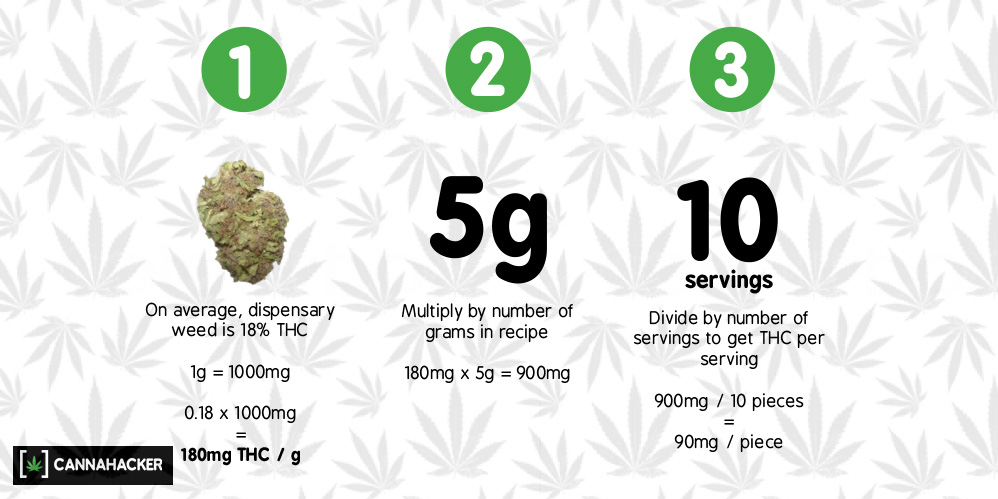How to Calculate Edible Potency in 3 Simple Steps
If you have ever indulged in homemade brownies, you know that sometimes the strength of homemade treats can be a little… unpredictable. Overdoing it with edibles is remarkably easy and can ruin a good time! Learning to calculate edible potency is simple following this guide. We recommend always taking notes because these numbers might get confusing.
In this article, we will use store-bought weed, from a dispensary. Store-bought cannabis has been tested and has an accurate THC percentage determined by a laboratory. If you do not have access to store-bought cannabis, it is usually safe to assume the THC percentage is around 10-15%.
Calculating Edible Potency
Remember: 1 gram of dried flower or bud is equal to 1000mg dry weight.
1. Calculate the milligrams of THC in one gram of your herb
We will use the example of one gram of store-bought flower or bud that is at 18% THC. That one gram of store-bought cannabis contains 180mg of THC. If you have bud that has not been tested, you can estimate there is between 100mg to 150mg of THC in one gram. Write that figure down somewhere.
2. Multiply by the number of grams in your recipe
To make any kind of edible treat, you need to extract THC from the cannabis into coconut oil or butter. In this article we will use coconut oil. Using five grams of the same flower from the example above (store-bought at 18% THC), 5g x 180mg = 900mg of THC. If this cannabis was used to make cannaoil, that oil would contain approximately 900mg of THC. So, using your bud, and your quantities, make the same calculations and make concise notes! It might look like this:
180mg x 5 grams = 900mg
The potency of the extracted cannabis depends upon the amount of coconut oil used: use more oil for less potent results.
Following on from last example: Take the ounce of cannabis flower with 18% THC from earlier (900mg of THC) and extract that into coconut oil, melted. (This process is outlined VERY basically here.) If you use three tablespoons of coconut oil, those three tablespoons of oil now contains approximately 900mg of THC. Three tablespoons of coconut oil is equal to nine teaspoons. So, 900mg divided by 9 teaspoons = 100mg. That means one teaspoon of this coconut oil contains 100mg of THC. This is just an example.
Using your own bud and quantities, make the same calculations. I will continue using the example from above. It might look like this:
900mg total, extracted into nine teaspoons of oil = 100mg per teaspoon, OR 900mg total, divided into ten pieces.
900 / 10 pieces = 90mg per piece.
How to Dose With THC
When you want to use the coco-cannaoil in baking, there are a couple options on how to dose.
- Replace the butter or oil in the recipe with cannabis coconut oil. If you are using a recipe that calls for half a cup of butter, use half a cup of coconut oil instead. Half a cup of coconut oil in might contains 2000mg of THC. If that recipe results in 30 cookies, do the math like this: 2000 divided by 30 = 66.66. That is approximately 67mg a cookie. Consider your ideal edible potency and adjust the ratio of coconut cannabis oil accordingly. (The more cannaoil you use, the less potent the edibles will be.)
- Using the formula from the example earlier, each teaspoon of this cannaoil contains 100mg of THC approximately. You can use this calculation to dose smaller quantities of foods: add a quarter teaspoon (approximately 25mg) to your coffee, or to your meal once it has come off the high heat. (High heat can cause THC to ‘burn off’ in edibles.) You can also add cannaoil to capsules using this method, or bake a single cupcake or muffin!


